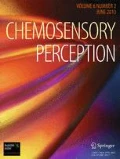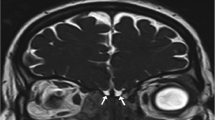Abstract
Introduction
In the recent years, olfactory disorders are described in a wide range of neurological disorders such as Alzheimer’s disease. Neurofibrillary tangles, one of the hallmark pathologic indicators of Alzheimer’s disease, have been identified within the olfactory bulb, olfactory tract, anterior olfactory nucleus, entorhinal cortex, and amygdala. Severity of dementia has been correlated with the number of neurofibrillary tangles within such.
Materials and Methods
The study was performed from the ENT Clinic of the University of Siena and from the University of Rome “Tor Vergata” laboratory; data were collected and analyzed by the ENT Clinic of the Catholic University of the Sacred Hearth, Rome. Twenty-five adult subjects with median age of 72.3 years were enrolled. Thirteen adult subjects with median age of 26.1 years, with neither history of nasal and/or olfaction and neurological disease, were enrolled as control group. All patients were studied through the Sniffin’ Sticks® olfactory test, performing the threshold, detection, and identification tests. All these tests were preceded by rhinomanometry and sensitized with nasal decongestion, in order to allow a correct odorants’ diffusion to olfactory epithelium.
Results
A significative tau protein and phosphorylated tau protein levels were detected in almost all the anosmic patients. All the controls were negative in tau protein dosage except for one in which a phosphorylated tau protein level of 70–90 pg/ml was found.
Conclusions
Our series, even if the present is a preliminary study, give an evidence about tau protein presence both in the naïve and in the phosphorylated form in nasal secretion obtained from Alzheimer’s disease patients.
Similar content being viewed by others
References
Arnold SE, Hyman BT, Flory J et al (1991) The topographical and neuroanatomical distribution of neurofibrillary tangles and neuritic plaques in the cerebral cortex of patients with Alzheimer’s disease. Cereb Cortex 1(1):103–116
Arnold SE, Lee EB, Moberg PJ, Stutzbach L, Kazi H, Han LY, Lee VM, Trojanowski JQ (2010) Olfactory epithelium amyloid-beta and paired helical filament-tau pathology in Alzheimer disease. Ann Neurol 67(4):462–469
Attems J, Jellinger KA (2006) Olfactory tau pathology in Alzheimer disease and mild cognitive impairment. Clin Neuropathol 25(6):265–271
Attems J, Walker L, Jellinger KA (2014) Olfactory bulb involvement in neurodegenerative diseases. Acta Neuropathol 127(4):459–475
Braak H, Braak E (1996) Evolution of the neuropathology of Alzheimer’s disease. Acta Neurol Scand Suppl 165:3–12
Braak H, Braak E (1998) Evolution of neuronal changes in the course of Alzheimer’s disease. J Neural Trans Suppl 53:127–140
Cleveland DW, Garcia ML (2001) Going new places using an old MAP: tau, microtubules and human neurodegenerative disease. Curr Opin Cell Biol 13:41
Devanand DP, Michaels-Marston KS, Liu X et al (2000) Olfactory deficits in patients with mild cognitive impairment predict Alzheimer’s disease at follow-up. Am J Psychiatry 157:1399–1405
Goedert M, Sisodia SS, Price DL (1991) Neurofibrillary tangles and beta-amyloid deposits in Alzheimer’s disease. Curr Opin Neurobiol 1(3):441–447
Hock C, Golombowski S, Muller-Spahn F et al (1998) Histological markers in nasal mucosa of patients with Alzheimer’s disease. Eur Neurol 40:31–36
Höglund K, Fourier A, Perret-Liaudet A, Zetterberg H, Blennow K, Portelius E (2015) Alzheimer’s disease - Recent biomarker developments in relation to updated diagnostic criteria. Clin Chim Acta. doi:10.1016/j.cca.2015.01.041
Hu J, Wang X, Liu D, Wang Q, Zhu LQ (2012) Olfactory deficits induce neurofilament hyperphosphorylation. Neurosci Lett 506(2):180–183
Hummel T, Erras A, Kobal G (1997) A test for the screening of taste function. Rhinology 35(4):146–148
Mesholam RI, Moberg PJ, Mahr RN, Doty RL (1998) Olfaction in neurodegenerative disease: a meta-analysis of olfactory functioning in Alzheimer’s and Parkinson’s diseases. Arch Neurol 55(1):84–90
Ogura JH, Stokstead P (1958) Rhinomanometry in some rhinologic diseases. Laryngoscope 68(12):2001–2014
Ohm TG, Braak H (1987) Olfactory bulb changes in Alzheimer’s disease. Acta Neuropathol 73(4):365–369
Rombaux P, Huart C, Deggouj N, Duprez T, Hummel T (2012) Prognostic value of olfactory bulb volume measurement for recovery in postinfectious and posttraumatic olfactory loss. Otolaryngol Head Neck Surg 147(6):1136–1141
Ruan Y, Zheng XY, Zhang HL, Zhu W, Zhu J (2012) Olfactory dysfunctions in neurodegenerative disorders. J Neurosci Res 90(9):1693–1700
Shi M, Sui YT, Peskind ER, Li G, Hwang H, Devic I, Ginghina C, Edgar JS, Pan C, Goodlett DR, Furay AR, Gonzalez-Cuyar LF, Zhang J (2011) Salivary tau species are potential biomarkers of Alzheimer disease. J Alzheimers Dis 27(2):299–305
Smutzer GS, Arnold SE, Doty RL, Trojanowski JQ (2003) Olfactory system neuropathology in neurodegenerative diseases and schizophrenia. In: Doty RL (ed) Handbook of Olfaction and Gustation. Marcel Dekker, New York
Tabaton M, Cammarata S, Mancardi GL et al (1991) Abnormal tau-reactive filaments in olfactory mucosa in biopsy specimens of patients with probable Alzheimer’s disease. Neurology 41(3):391–394
Talamo BR, Rudel R, Kosik KS et al (1989) Pathological changes in olfactory neurons in patients with Alzheimer’s disease. Nature 337(6209):736–739
Thomann A, Dos SV, Toro P, Schonknecht P, Essig M, Schroder J (2009) Reduced olfactory bulb and tract volume in early Alzheimer’s disease—a MRI study. Neurobiol Aging 30(5):838–841
Yamagishi M, Ishizuko Y, Seki K (1994) Pathology of olfactory mucosa in patients with Alzheimer’s disease. Ann Otol Rhinol Laryngol 103:421–427
Author information
Authors and Affiliations
Corresponding author
Ethics declarations
Ethical Approval
All procedures performed in studies involving human participants were in accordance with the ethical standards of the institutional and/or national research committee and with the 1964 Helsinki declaration and its later amendments or comparable ethical standards.
Conflict of Interest
The authors declare that they have no competing interests.
Informed Consent
Informed consent was obtained from all individual participants included in the study.
Rights and permissions
About this article
Cite this article
Passali, G.C., Politi, L., Crisanti, A. et al. Tau Protein Detection in Anosmic Alzheimer’s Disease Patient’s Nasal Secretions. Chem. Percept. 8, 201–206 (2015). https://doi.org/10.1007/s12078-015-9198-3
Received:
Accepted:
Published:
Issue Date:
DOI: https://doi.org/10.1007/s12078-015-9198-3




